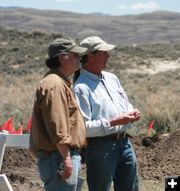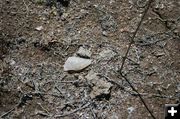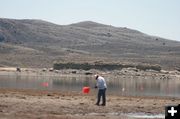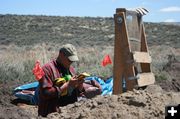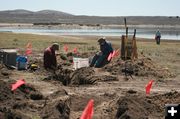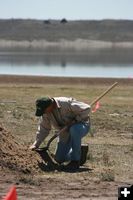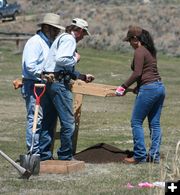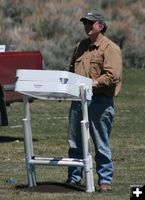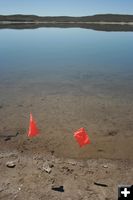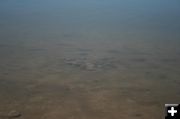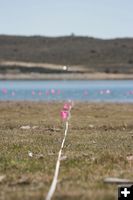
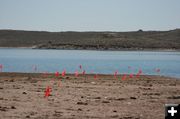
Boulder Lake Test Dig
Orange pin flags mark the location of artifacts found on the lakeshore. The artifacts will be photographed and recorded.
|

Volunteers found a variety of artifact flakes on the lake shoreline and several campfires and pits were located.
|

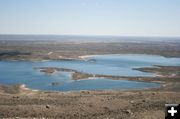
Boulder Lake
Boulder Lake is located on the western flank of the Wind River Mountains, appproximately eight miles east of Pinedale (as the crow flies).
|

Special thanks to volunteers Bob and Donna Diehl, Rose Sterling, Al Radke, Sandy Bousman, Dutch Daunt, George Peck, Mike and Stephanie Harker, Bill Williams, Victoria Goodin, Betty Gifford, Laura Weingartner and Mitch Lane for their help. Scroll down for more photos.
|
|
Boulder Lake Public Archaeological Evaluative Test Dig
Hosted by the BLM on May 16-18
by Pinedale Online!
May 26, 2008
The Bureau of Land Management (BLM) Pinedale Field Office sponsored archaeological evaluative test excavations at the BLM campground on Boulder Lake on May 16-18, 2008.
Members of the public were invited to participate or visit the excavations and talk to the archaeologists. Special thanks to volunteers Bob and Donna Diehl, Rose Sterling, Al Radke, Sandy Bousman, Dutch Daunt, George Peck, Mike and Stephanie Harker, Bill williams, Victoria Goodin, Betty Gifford, Laura Weingartner and Mitch Lane for their help with the excavations. Numerous locals also stopped by to visit the dig. Out-of-state visitors from Colorado, Oregon, Illinois and Utah were pleasantly surprised to stumble upon the project.
The purpose was to record and evaluate a known pre-historic camp site for National Register significance, and probe the potential extent of archaeological deposits around the camp ground. "The study area is rich in prehistoric occupations and much of Boulder Lake's archaeological past is intact, buried beneath up to two feet of sediments," Dave Vlcek, BLM Archaeologist for the Pinedale Field Office, said.
The location is believed to be where John C. Fremont camped on his 1842 expedition to climb Fremont Peak.
Volunteers found a variety of artifact flakes on the lake shoreline and several campfires and pits were located. Surface finds were marked with bright orange pin flags. Artifacts were photographed and their location recorded. Sites will ultimately become submerged as spring melt refills the lake.
Vlcek asked us to remind the public that the collection of artifacts by non-professional archaeologists is illegal and subject to penalty under federal law.
The "public dig" concept is a great avenue to allow the public to assist in the professional recordation of archaeological materials. All artifacts are sent to be studied by professionals and are then archived in specially-designated facilities that are licensed to archive artifacts from public lands. Vlcek said he is toying with the idea of a local museum display, but the local museums are pretty full already. (“HINT...HINT NEED FOR AN ADDITION!!,” he said.)
One of the purposes for the public dig, and this article, is to raise public awareness of the importance of the archaeological resource and enlist the public's help and support in helping protect and learn more about these important sites. "We collected a huge volume of important archaeological data due to the hard work of the volunteer," Vlcek said. The archaeological specimens will be sent away for lab analysis.
Anyone interested in learning more about the historical significance of public archaeology generally, or Boulder Lake in particular, is encouraged to contact one of the BLM archaeologists for more information. Contact Dave Vlcek, 307-367-5327, Sam Drucker, 307-367-5358, Dave Crowley, 307-367-5323 or Rob Schweitzer, 307-367-5325 with the Pinedale Field Office of the Bureau of Land Management.
Photos by Dawn Ballou, Pinedale Online!
|


